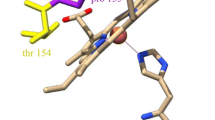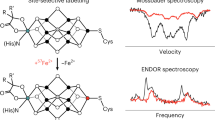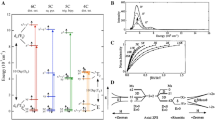Abstract
Methyl-coenzyme M reductase (MCR) catalyzes the methane-forming step in methanogenic archaea. It contains the nickel porphinoid F430, a prosthetic group that has been proposed to be directly involved in the catalytic cycle by the direct binding and subsequent reduction of the substrate methyl-coenzyme M. The active enzyme (MCRred1) can be generated in vivo and in vitro by reduction from MCRox1, which is an inactive form of the enzyme. Both the MCRred1 and MCRox1 forms have been proposed to contain F430 in the Ni(I) oxidation state on the basis of EPR and ENDOR data. In order to further address the oxidation state of the Ni center in F430, variable-temperature, variable-field magnetic circular dichroism (VTVH MCD), coupled with parallel absorption and EPR studies, have been used to compare the electronic and magnetic properties of MCRred1, MCRox1, and various EPR silent forms of MCR, with those of the isolated penta-methylated cofactor (F430M) in the +1, +2 and +3 oxidation states. The results confirm Ni(I) assignments for MCRred1 and MCRred2 forms of MCR and reveal charge transfer transitions involving the Ni d orbitals and the macrocycle π orbitals that are unique to Ni(I) forms of F430. Ligand field transitions associated with S=1 Ni(II) centers are assigned in the near-IR MCD spectra of MCRox1-silent and MCR-silent, and the splitting in the lowest energy d–d transition is shown to correlate qualitatively with assessments of the zero-field splitting parameters determined by analysis of VTVH MCD saturation magnetization data. The MCD studies also support rationalization of MCRox1 as a tetragonally compressed Ni(III) center with an axial thiolate ligand or a coupled Ni(II)-thiyl radical species, with the reality probably lying between these two extremes. The reinterpretation of MCRox1 as a formal Ni(III) species rather than an Ni(I) species obviates the need to invoke a two-electron reduction of the F430 macrocyclic ligand on reductive activation of MCRox1 to yield MCRred1.







Similar content being viewed by others
Abbreviations
- F430 :
-
cofactor 430
- F430M:
-
penta-methylated form of cofactor 430
- Ni(I)F430M:
-
F430M with the nickel atom in the +1 oxidation state
- Ni(II)F430M:
-
F430M with the nickel atom in the +2 oxidation state
- Ni(III)F430M:
-
F430M with the nickel atom in the +3 oxidation state
- MCR:
-
methyl-coenzyme M reductase
- MCRox1:
-
MCR exhibiting the MCR-ox1 EPR signal
- MCRox1-silent:
-
EPR silent form of MCR obtained from the MCRox1 form
- MCRred1:
-
MCR exhibiting the EPR signals red1c and/or red1m
- MCRred1c:
-
MCRred1 in the presence of coenzyme M
- MCRred1m:
-
MCRred1 in the presence of methyl-coenzyme M
- MCRred2:
-
MCR exhibiting both the red1 and red2 EPR signals
- MCRred1-silent:
-
EPR silent form of MCR obtained from the MCRred1 form
- MCRsilent:
-
EPR silent form of MCR
References
Thauer RK (1998) Microbiology 144:2377–2406
Pfaltz A, Jaun B, Fässler A, Eschenmoser A, Jaenchen R, Gilles HH, Diekert G, Thauer RK (1982) Helv Chim Acta 65:828–865
Färber G, Keller W, Kratky C, Jaun B, Pfaltz A, Spinner C, Kobelt A, Eschenmoser A (1991) Helv Chim Acta 74:697–716
Hamilton CL, Scott RA, Johnson MK (1989) J Biol Chem 264:11605–11613
Cheesman MR, Ankel-Fuchs D, Thauer RK, Thompson AJ (1989) Biochem J 260:613–616
Pfaltz A, Livingston DA, Jaun B, Diekert G, Thauer RK, Eschenmoser A (1985) Helv Chim Acta 68:1338–1358
Shiemke AK, Shelnutt JA, Scott RA (1989) J Biol Chem 264:11236–11245
Hamilton CL, Ma L, Renner MW, Scott RA (1991) Biochim Biophys Acta 1074:312–319
Jaun B (1993) In: Sigel H, Sigel A (eds) Metal ions in biological systems. Marcel Dekker, New York, pp 287–337
Jaun B (1990) Helv Chim Acta 73:2209–2217
Goubeaud M, Schreiner G, Thauer RK (1997) Eur J Biochem 243:110–114
Mahlert F, Bauer C, Jaun B, Thauer RK, Duin EC (2002) J Biol Inorg Chem 7:500–513
Mahlert F, Grabarse W, Kahnt J, Thauer RK, Duin EC (2002) J Biol Inorg Chem 7:101–112 and 7:151
Duin EC (2004) In: Warren MJ, Smith A (eds) Tetrapyrroles: their birth, life and death. Landes Bioscience, Georgetown (in press)
Ragsdale SW (2003) In: Kadish KM, Smith KM, Guilard R (eds) Porphyrin handbook. Elsevier, San Diego, pp 205–228
Ermler U, Grabarse W, Shima S, Goubeaud M, Thauer RK (1997) Science 278:1457–1462
Grabarse W, Mahlert F, Shima S, Thauer RK, Ermler U (2000) J Mol Biol 303:329–344
Grabarse W, Mahlert F, Duin EC, Goubeaud M, Shima S, Thauer RK, Lamzin V, Ermler U (2001) J Mol Biol 309:315–330
Grabarse W, Shima S, Mahlert F, Duin EC, Thauer RK, Ermler U (2001) In: Messerschmidt A, Huber R, Poulos T, Wieghardt K (eds) Handbook of metalloproteins. Wiley, Chichester, pp 897–914
Duin EC, Cosper NJ, Mahlert F, Thauer RK, Scott RA (2003) J Biol Inorg Chem 8:141–148
Tang Q, Carrington PE, Horng YC, Maroney MJ, Ragsdale SW, Bocian DF (2002) J Am Chem Soc 124:13242–13256
Telser J, Davydov R, Horng Y-C, Ragsdale SW, Hoffman BM (2001) J Am Chem Soc 123:5853–5860
Telser J, Horng Y-C, Becker DF, Hoffman BM, Ragsdale SW (2000) J Am Chem Soc 122:182–183
Finazzo C, Harmer J, Jaun B, Duin EC, Mahlert F, Thauer RK, Van Doorslaer S, Schweiger A (2003) J Biol Inorg Chem 8:586–593
Finazzo C, Harmer J, Bauer C, Jaun B, Duin EC, Mahlert F, Goenrich M, Thauer RK, Van Doorslaer S, Schweiger A (2003) J Am Chem Soc 125:4988–4989
Rospert S, Böcher R, Albracht SPJ, Thauer RK (1991) FEBS Lett 291:371–375
Piskorski R, Jaun B (2003) J Am Chem Soc 125:13120–13125
Wasserfallen A, Nölling J, Pfister P, Reeve J, de Macario EC (2000) Int J Syst Evol Microbiol 50:43–53
Kobelt A, Pfaltz A, Ankel-Fuchs D, Thauer RK (1987) FEBS Lett 214:265–268
Ellermann J, Hedderich R, Böcher R, Thauer RK (1988) Eur J Biochem 172:669–677
Schönheit P, Moll J, Thauer RK (1980) Arch Microbiol 127:59–65
Rospert S, Linder D, Ellermann J, Thauer RK (1990) Eur J Biochem 194:871–877
Bonacker LG, Baudner S, Thauer RK (1992) Eur J Biochem 206:87–92
Bonacker LG, Baudner S, Mörschel E, Böcher R, Thauer RK (1993) Eur J Biochem 217:587–595
Jaun B, Pfaltz A (1986) J Chem Soc Chem Commun 1327–1329
Bradford MM (1976) Anal Biochem 72:248–254
Johnson MK (1988) In: Que L Jr (ed) Metal clusters in proteins. American Chemical Society, Washington, DC, pp 326–342
Thomson AJ, Cheesman MR, George SJ (1993) Methods Enzymol 226:199–232
Johnson MK (2000) In: Que L Jr (ed) Physical methods in bioinorganic chemistry. University Science Books, Sausalito, pp 233–285
Neese F, Solomon EI (1999) Inorg Chem 38:1847–1865
Beinert H, Albracht SPJ (1982) Biochim Biophys Acta 683:245–277
Margerum DW, Anliker SL (1988) In: Lancaster JR Jr (ed) The bioinorganic chemistry of nickel. VCH Verlagsgesellschaft, Weinheim, Germany, pp 29–51
Salerno JC (1988) In: Lancaster JR Jr (ed) The bioinorganic chemistry of nickel. VCH Verlagsgesellschaft, Weinheim, Germany, pp 53–71
Renner MW, Fajer J (2001) J Biol Inorg Chem 6:823–830 and (2002) 7:352
Ma L (1993) PhD Thesis, University of Georgia, Athens, GA, USA
Knuppe K (1997) PhD Thesis, ETH Zürich, Switzerland
Busch DH (1966) Helv Chim Acta 174–182
Craft JL, Horng Y-C, Ragsdale SW, Brunold TC (2004) J Biol Inorg Chem 9:77–89
Suh MP, Kim HK, Kim MJ, Oh KY (1992) Inorg Chem 31:3620–3625
Acknowledgements
This work was supported by the Max-Planck-Gesellschaft (R.K.T), by the Fonds der Chemischen Industrie (R.K.T.), and by grants from the National Institutes of Health (GM60329 and GM62542 to M.K.J.), the National Science Foundation (MCB98008857 to M.K.J) and the Swiss National Science Foundation (20-66773 to L.S, R.P, B.J). M.G is a recipient of a scholarship of the Claussen-Simon-Stiftung. We thank Dr. Richard C. Conover for help in fitting the VHVT MCD saturation magnetization data and the reviewers for many insightful comments and suggestions.
Author information
Authors and Affiliations
Corresponding author
Electronic Supplementary Material
Rights and permissions
About this article
Cite this article
Duin, E.C., Signor, L., Piskorski, R. et al. Spectroscopic investigation of the nickel-containing porphinoid cofactor F430. Comparison of the free cofactor in the +1, +2 and +3 oxidation states with the cofactor bound to methyl-coenzyme M reductase in the silent, red and ox forms. J Biol Inorg Chem 9, 563–576 (2004). https://doi.org/10.1007/s00775-004-0549-9
Received:
Accepted:
Published:
Issue Date:
DOI: https://doi.org/10.1007/s00775-004-0549-9




